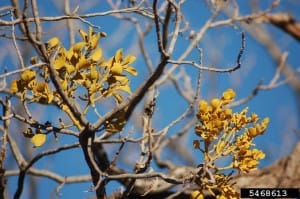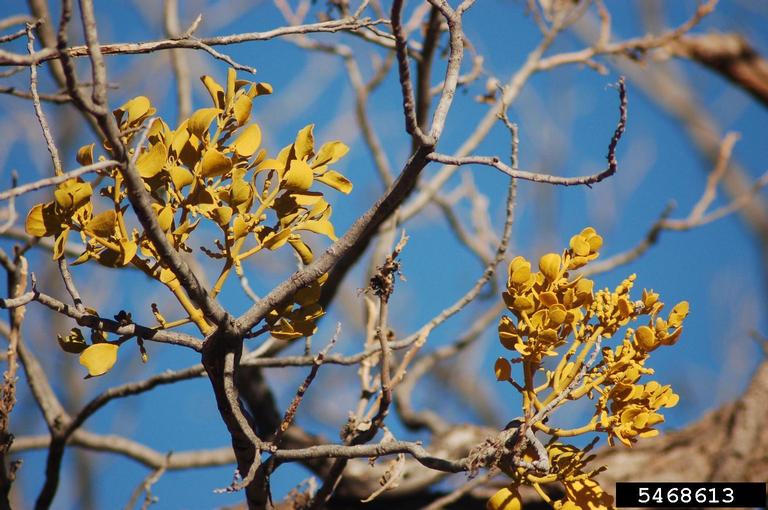
This is an excerpt from American Mistletoe Infection in Trees by Kim Coder, Professor of Tree Health Care, University of Georgia. For more complete information, including images, see the original publication here.
There are currently three mistletoe elimination interventions, each delivering varying results. The three interventions are pruning infected tree branches, shoot pruning of mistletoe, and/or using a labeled chemical spray (ethephon). Note any specific commercial product mentioned here does not represent an endorsement, nor a statement of efficaciousness, but a summary of marketplace information at the time this publication was prepared.
Tree Pruning – Infection site branch pruning is a common means of controlling mistletoe. A twig or branch infected with mistletoe can be pruned at the nearest healthy originating node below an infection site. Do not tip, top, or use internode cuts on a twig or branch. (See Figure 11 in original publication online). The target node for pruning should be at least 14 inches below an infection site. Mistletoe infection site elimination through branch pruning should be treated as a proper pruning (Figure 12) or reduction cut (Figure 13, Figure 14, Figure 15). Figures in the original publication show proper cuts to be made at the next lowest branch node greater than 14 inches below an infection. Years will be needed for a tree to regain structural integrity after extensive mistletoe removal pruning.
Mistletoe Shoot Removal – One traditional treatment for mistletoe infection is to knock off brittle mistletoe stems from tree branches. Mistletoe stems snap off easy and nearly flush with branch bark, usually at the remnants of the holdfast leaving the haustorial cushion behind still within a branch. This treatment immediately reduces water loss from a tree, and reduces mistletoe reproduction. Unfortunately, simply knocking off mistletoe stems does not eliminate infections because the endophytic part of the mistletoe remains intact. It usually takes 1-3 years before mistletoe shoots noticeably reappear after removal. Approximately 80% of all pruned mistletoe stems re-grow and while without green shoots, become completely parasitic on a tree. Periodic mistletoe shoot removal may be a viable treatment on main stem infections where pruning is not practical.
A few studies have used a combination of mistletoe shoot removal and blocking light to the haustorial cushion. Light has been excluded from haustoria by various wraps, sprays, and applications like heavy pruning paint applications, aluminum foil, tin disks, tarpaper, tape, caulking, or black plastic. It is critical to not injure tree tissues around an infection site with any topical coating or through affixing any covering. Mistletoe shoot pruning and light exclusion from an infection site was thought to prevent new mistletoe shoot formation and starve haustoria embedded in tree branches. Generally, these types of mistletoe shoot stub treatment have not been found to be completely effective and so, not recommended in most circumstances.
Chemical Spray – (Note that pesticide information was correct as of August 2008 – labeled uses can change. Check the pesticide label for the most recent information!) Ethephon [(2-chloroethyl) phosphonic acid] acts as a mistletoe shoot abscission and defoliator by generating ethylene, a plant growth regulator. For example in one study, a 2% ethephon treatment applied to mistletoe shoots in the dormant season defoliated shoots in 75 days with no resprouting for 225 days, and with no negative impacts on the host. This treatment did not significantly impact the haustoria and new sprouts from the haustorial cushion area formed within 1-2 years.
Currently there is a chemical product labeled for mistletoe shoot control which contains this shoot abscission chemical (ethephon). This product is sold under the name FLOREL brand growth regulator, a trademark of the Rhone-Poulenc AG Company, and distributed by Monterey Lawn & Garden Products, Fresno, CA. [EPA Registration Number 54705-8]. Information for this publication regarding this product came from the company’s web site (accessed 8/29/2008). All label information was derived from the electronic version of the chemical product label.
The product as currently formulated contains 3.9% ethephon (0.33 lbs ethephon per gallon). The chemical is a highly acidic, colorless, odorless, clear liquid. This labeled product “… will cause the abscission of … leafy mistletoe shoots in ornamental deciduous trees.” Technically, this product is not labeled for leafy mistletoe removal from evergreen trees. Note a wide variety of other concentrations and application methods have been used in past research papers.
This ethephon product should be sprayed directly on mistletoe clumps until foliage and stems are wet.
Timing is crucial to prevent tree damage. Spraying should be completed after Fall leaf drop and before tree bud burst in Spring when daytime temperatures are above 65oF. Mix the product following all label directions. For example, under current label mixing instructions, mix one quart of product in 2 gallons of water for 5400 ppm concentration. Use of a surfactant is recommended. Spray only when no rain is forecast for a minimum of 24 hours. Return to and re-spray large clumps of mistletoe in one week. Because only the mistletoe shoot is impacted, retreat every 3-4 years. Mix and spray this product immediately. Do not store the mixed spray liquid for more than a few hours. Care is needed to prevent over-spray from staining or etching hardscapes or damaging painted surfaces.
Remember to carefully read and review the product label for your personal safety, safety of other living things, and the legal context of product use. Do not use this product near individuals or habitats of protected species, some of which could be around the tree site or on the tree exterior.
See the entire publication Mistletoe Infection in Trees here.
Image credit – Joy Viola, Northeastern University, Bugwood.org
